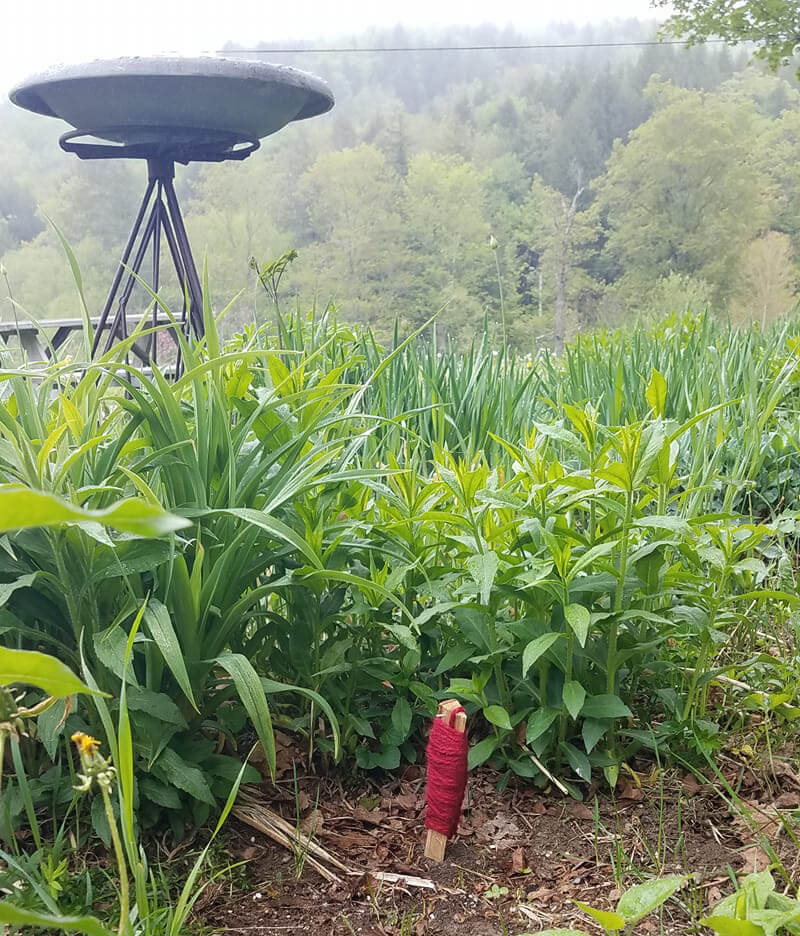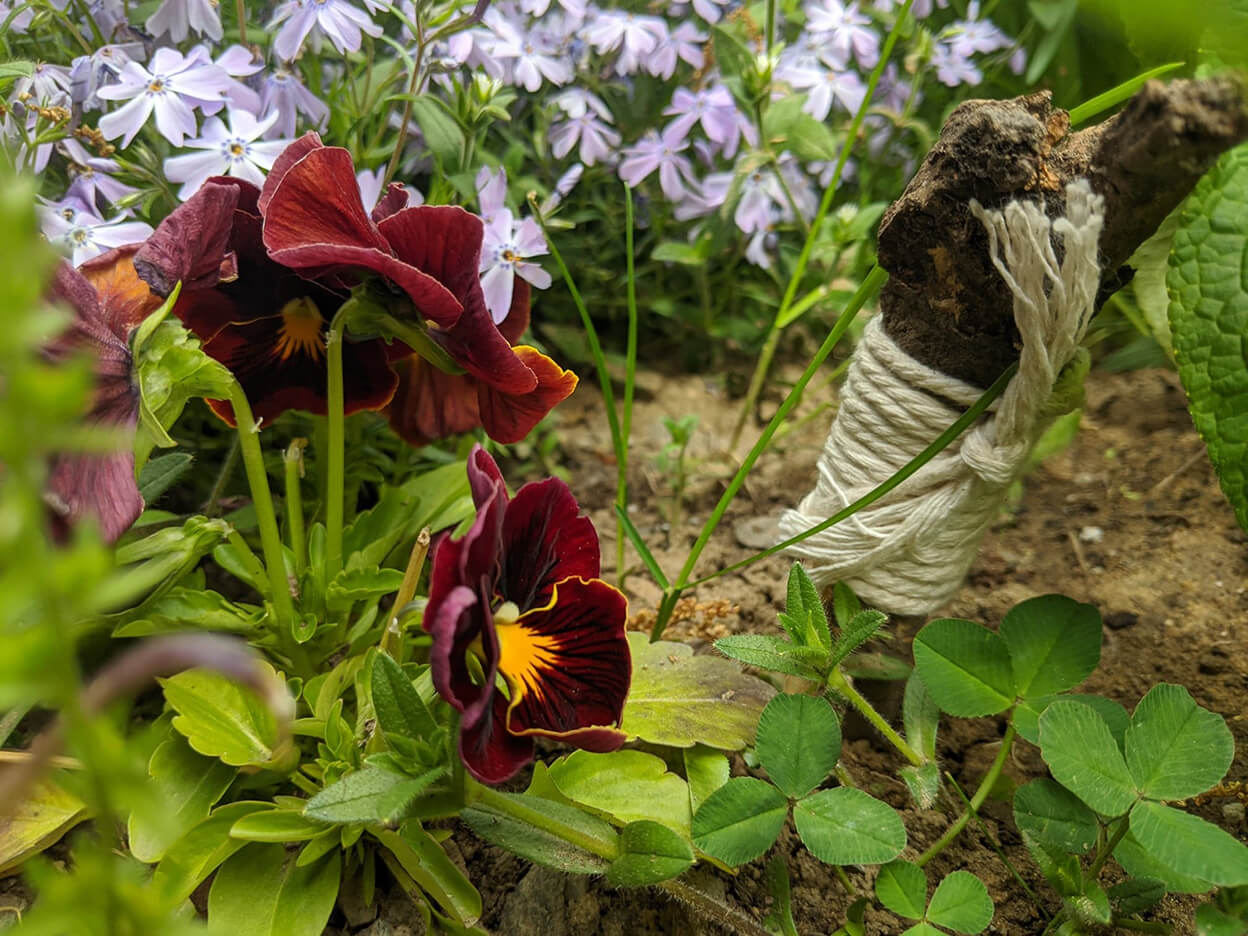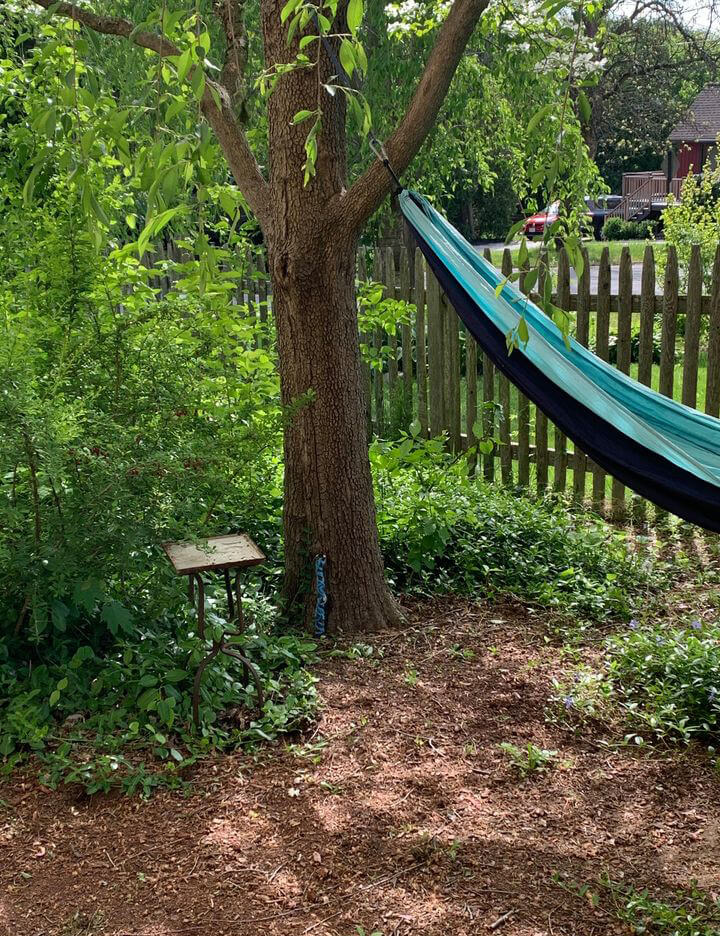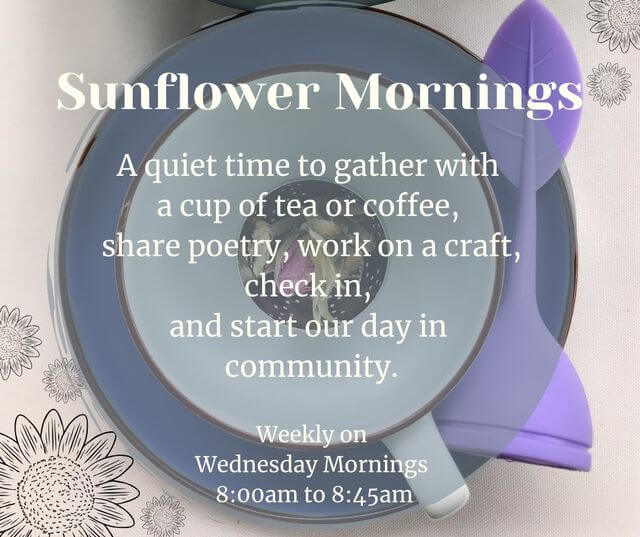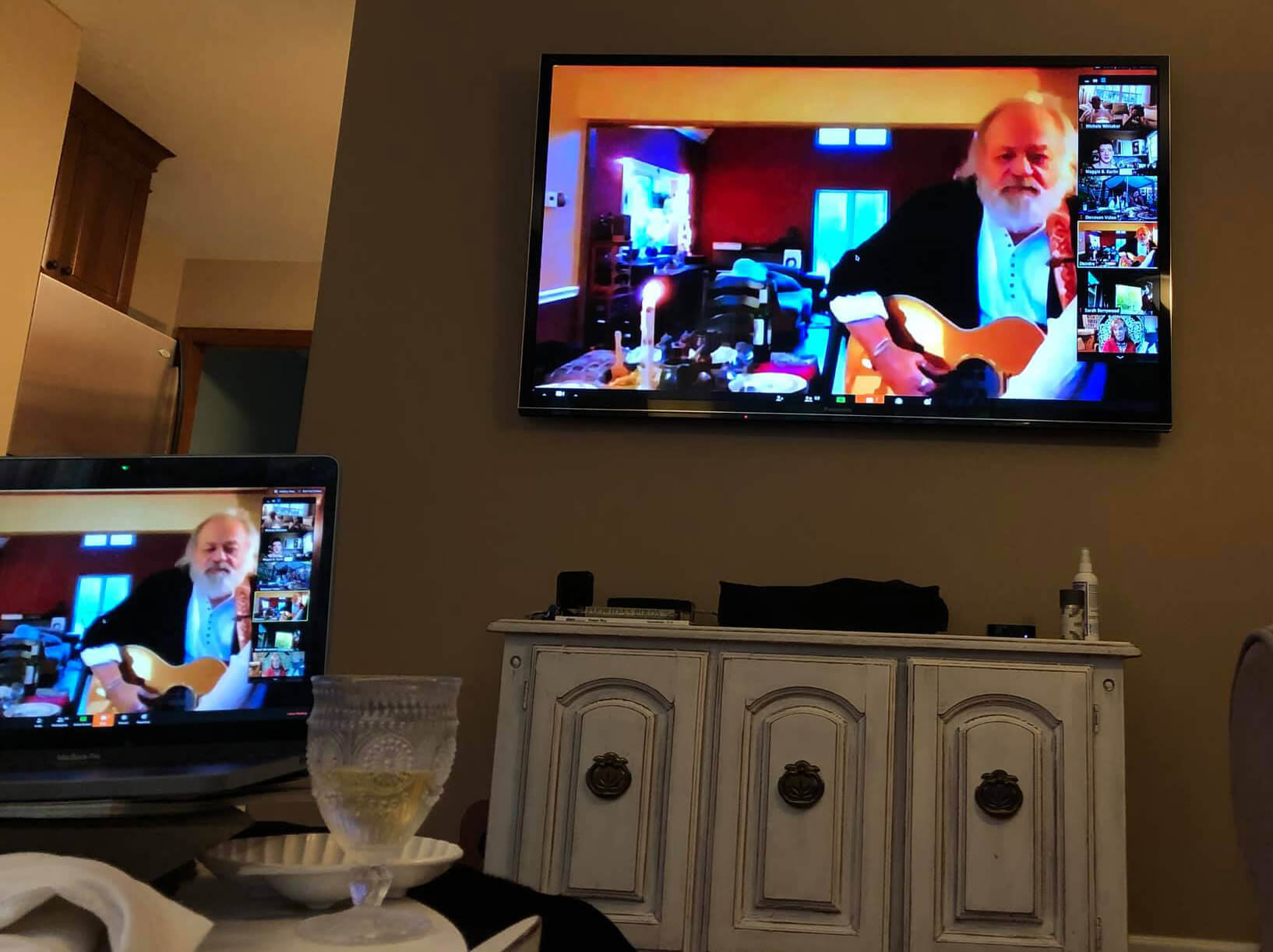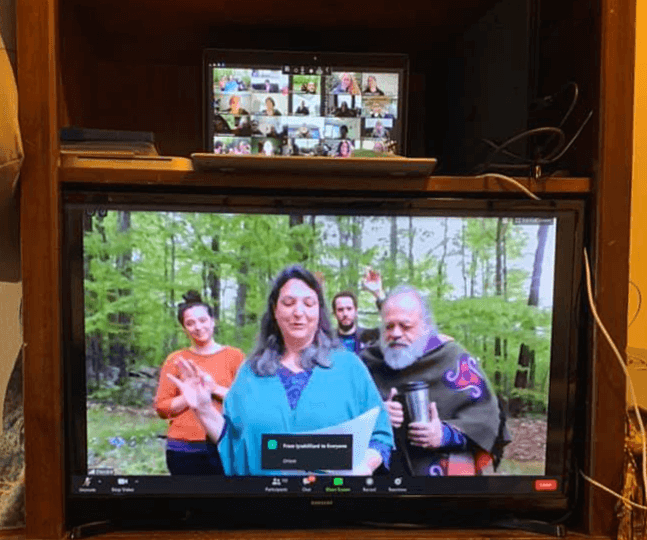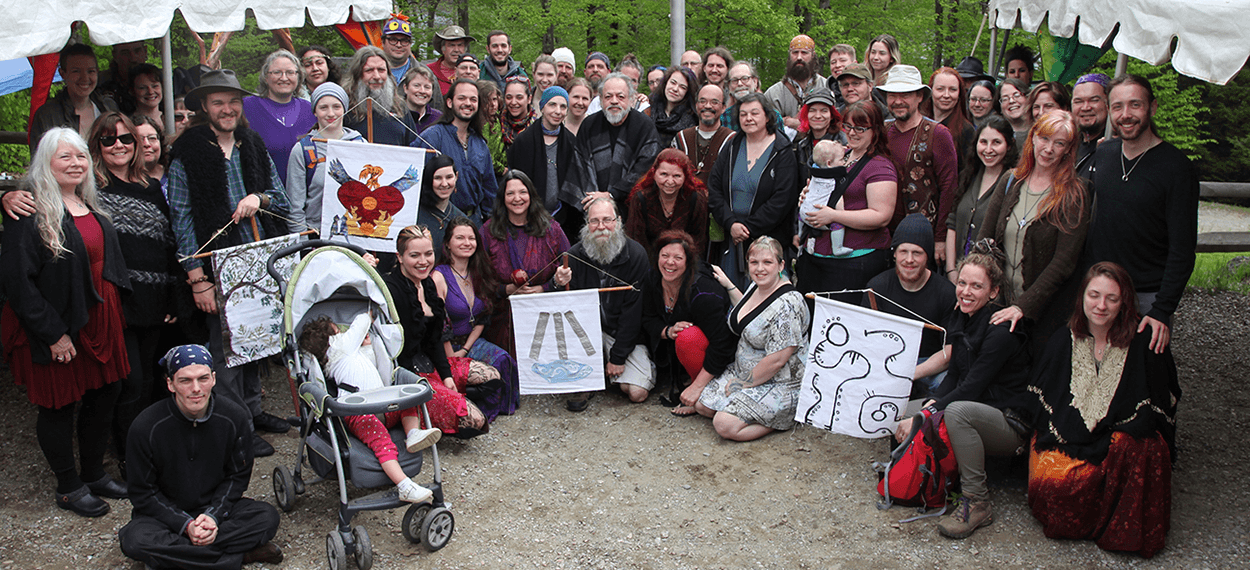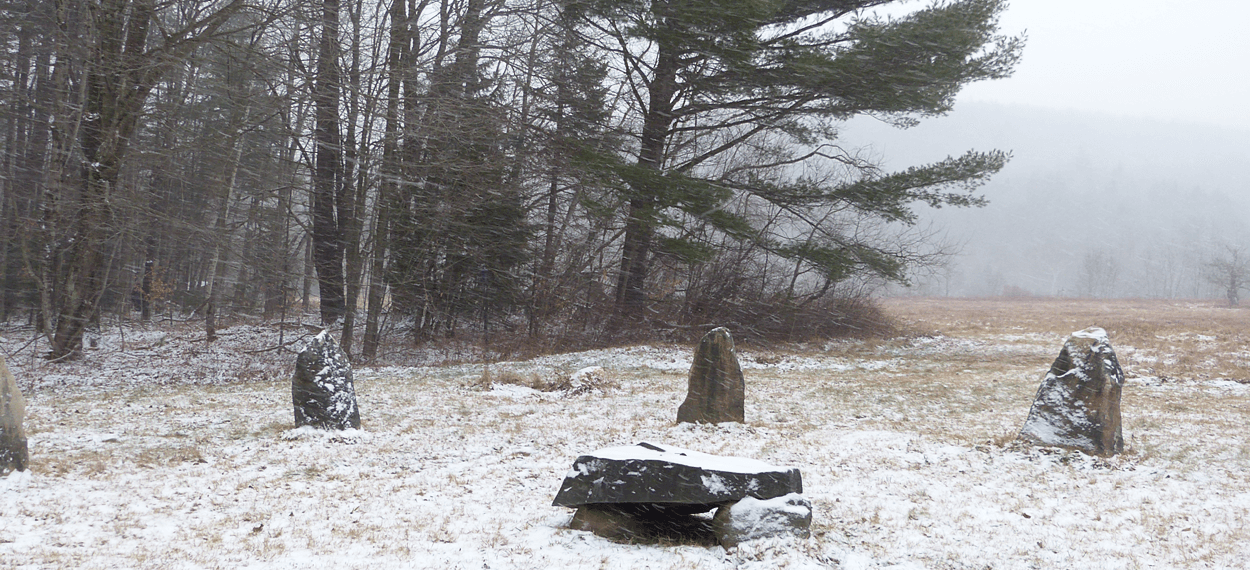 EarthSpirit
EarthSpirit
2020: What a year it has been!
2020 is a year that will remain in memory as an extremely challenging time for all of us. The COVID-19 pandemic, the rising visibility and unrest around racial injustice in the US, and the national election have all come together to create great stress for individuals and organizations. For EarthSpirit, despite the struggles, this has been a year of learning about the strength of our community at a time of crisis, and a year of focus and growth despite hardship. We have learned new skills, supported each other in new ways, and moved forward with projects that have been waiting for years. As I sit to write about it all, I feel most grateful to all of you for your confidence in us, and for the generosity and commitment shown by our members and volunteers.
Rites of Spring 2020 stakes in the ground
The organizational side of EarthSpirit grew stronger this year. The Board of Directors focused on furthering the work of three major planning committees: Membership, Program, and Fundraising. You can expect to hear directly from the Fundraising Committee later this month. These groups, which are composed of community members in addition to Board members, will guide the priorities of the organization as it grows into the next 5 years. In February, we welcomed our second ever full-time intern, Kael Alberghini, who has spearheaded many projects that have been on the back burner for years and that could have lingered there for many more without his time, attention, and skills. These include implementing a new database system for EarthSpirit, creating templates for our newsletters, processing trademark applications, and leading the labyrinth restoration project.
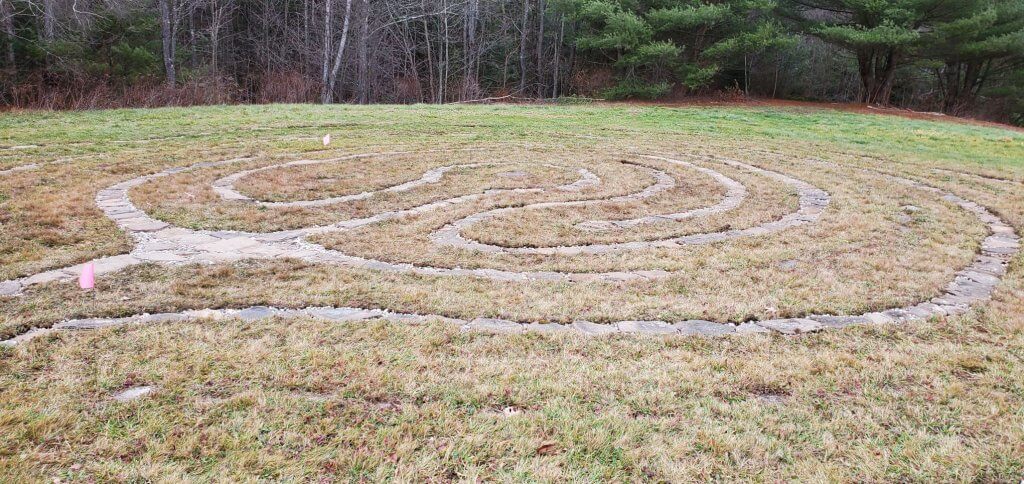
We are so grateful for his gift of a year of his time. Donovan Arthen has been Kael’s mentor for the year, and has also developed a new bookkeeping and accounting system this year and transferred all of our old records into it. All of these changes will make a huge difference in how smoothly EarthSpirit functions.
A Feast of Lights was a beautiful event in February, and its memory is even sweeter because it was the last time that we came together as a physical community. As we looked toward the spring, we realized that it would not be possible to hold our Beltaine rituals or Rites of Spring in person, so we began to learn about Zoom and we held a virtual Maypole, then a full five days of Rites of Spring programming, complete with rituals, a Feast, concerts, and a dance party. Our volunteers learned Zoom on the fly and were phenomenal at creating an online event that offered connection and community in the best ways we knew how. The same was true of Twilight Covening this October, our Clan Leaders and Assistants were phenomenal, as were all of the volunteers who staffed Zoom and created ritual or video in advance. What we have found though, as this year has unfolded, is that our success has also depended on the investment and commitment each of you has brought. We create the framework and really excellent programming, but to make the connections real, it has taken every one of you: your participation, your connection to the deep roots we have built together over the last forty years, and your willingness and desire to dream of the many ways we’ll continue to build over the next forty. Together, we have held the pulse of EarthSpirit strong and it has flourished during the most challenging year of its existence.
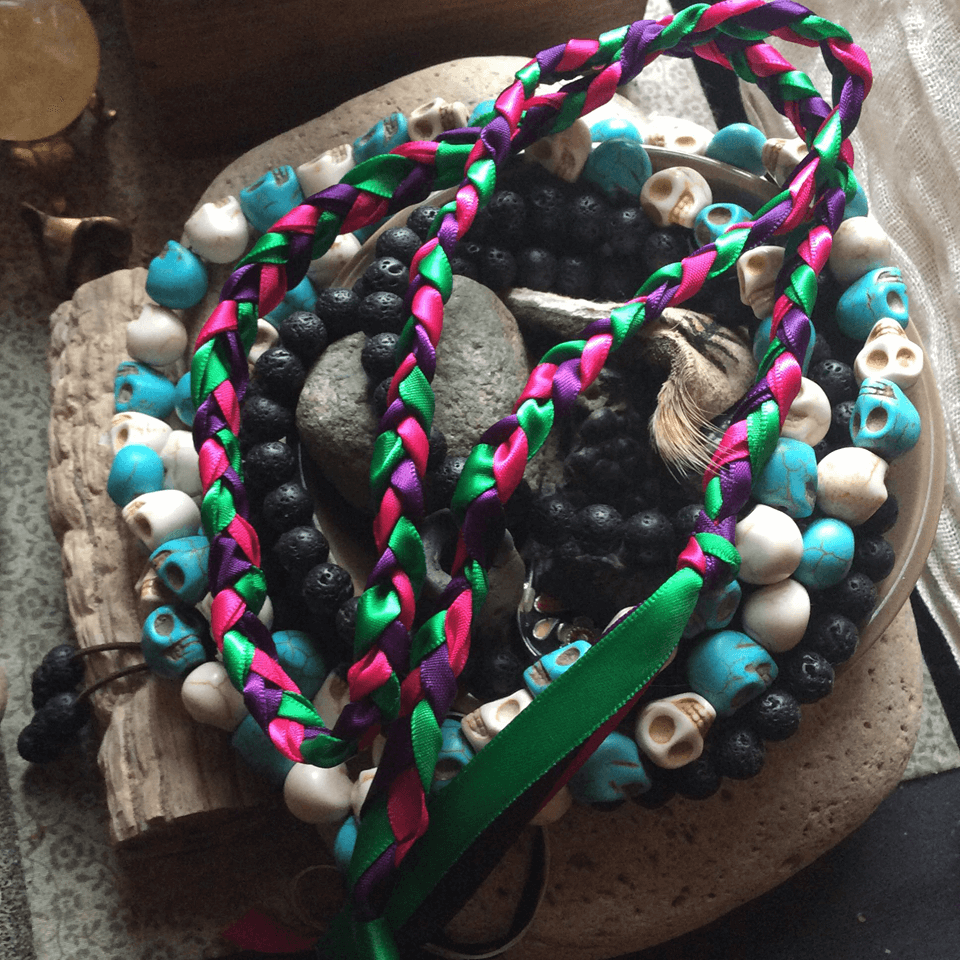
Our live online programs have expanded. Sacred Land, our monthly event series at Glenwood Farm, morphed into EarthSpirit Saturdays. This bi-monthly Zoom event, organized by ES Board member Sarah Rosehill with a rolling list of volunteers, offers workshops, discussions, and seasonal rituals free of charge to the whole community. Sunflower Mornings, hosted by Anya Arthen, takes place every Wednesday morning and offers a gentle way to begin the day and an opportunity for community connections.
Special events, such as the upcoming Winter Goblin Market (November 28) and the election night multi-community Zoom meet-up, bring opportunities for even more connection and mutual support. We’ll continue these regular programs moving forward, and we look forward to bringing you a special series of online workshops this fall and winter as well as Feast of Lights and Rites of Spring 2021! It has been a delight to connect more often with long-time members who have moved further away, and we look forward to seeing more and more members around the world as we come together from wherever we are.
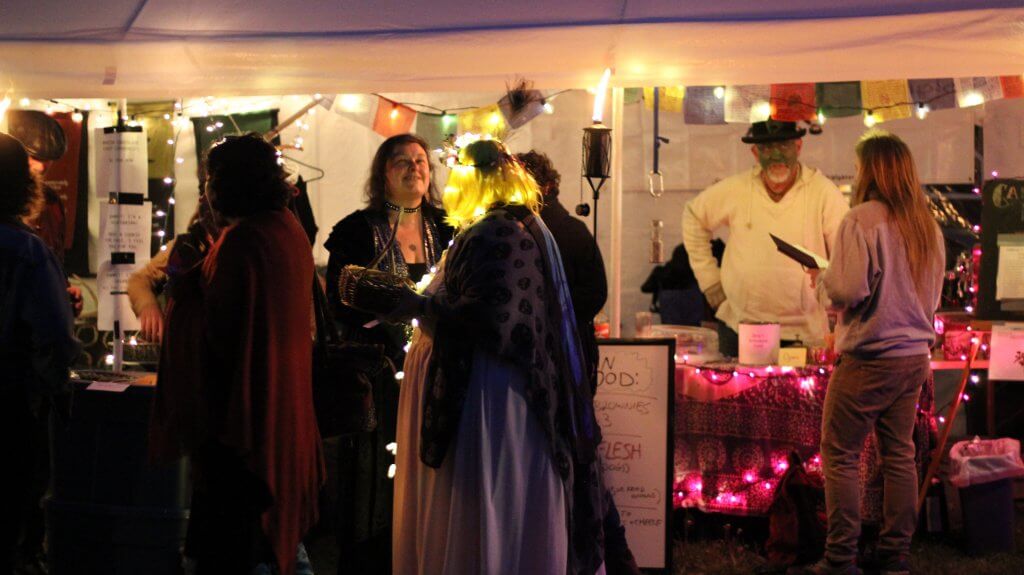
EarthSpirit has maintained its connections with other communities this year as well. Our EarthWays Initiative, which works to build bridges with Indigenous communities worldwide, brought ES Board members, Andras Corban Arthen and Donovan Arthen, to two international online events hosted by the Grandmothers of the Sacred We. Andras also continued to work with the Parliament of the World’s Religions and Donovan taught at Chicago Pagan Pride this fall as well.
There is nothing like the power of being together in person: holding rituals where we can feel each others’ presence, singing together, being in the intimate company of wise teachers, experiencing rites of passage, and sharing affection and hugs. Of course, we want to be together again as soon as we can. In the meantime though, keep an eye on the website, the Newsletter and the Facebook pages and with your continued support and participation, EarthSpirit will continue to thrive.
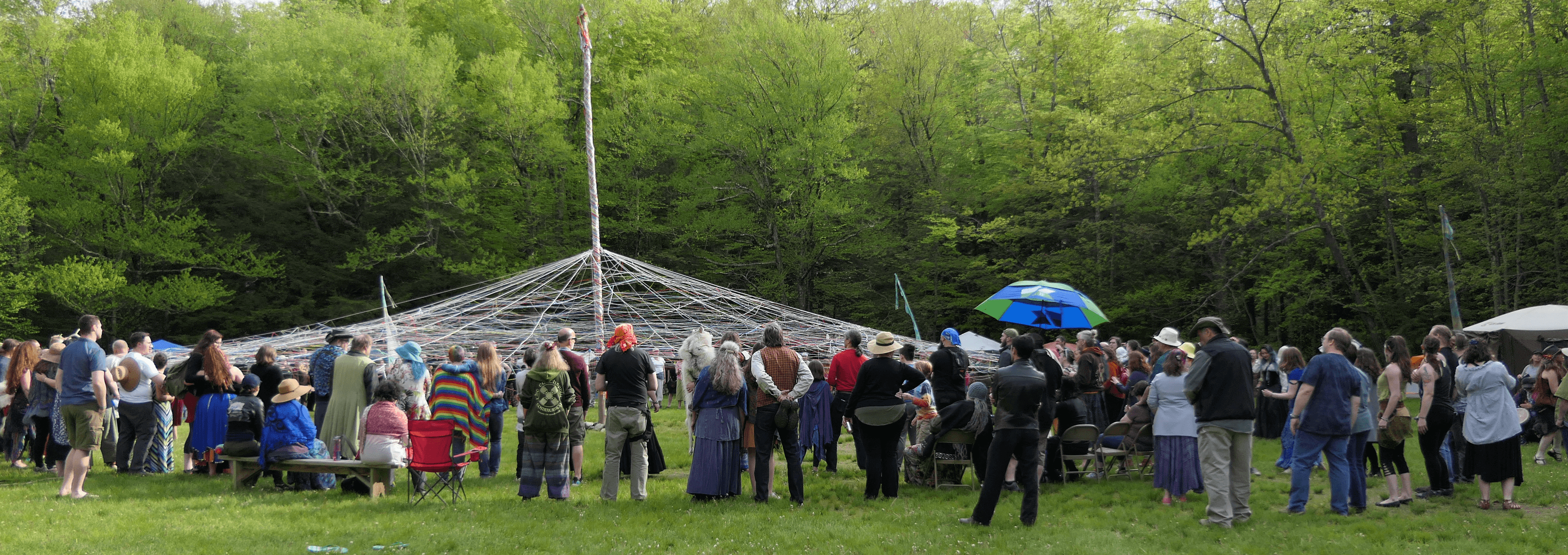
End of Year Letter 2018
Dear friends,
As we move into the winter and the end of 2018, we are glad to reach out to our community members and friends to look back on what has been another remarkable year for EarthSpirit, and to acknowledge all of you who have helped to make it so. Many of you have volunteered dozens of hours teaching, organizing, staffing or planning for EarthSpirit events. Others of you have made one or more financial contributions already this year. So many people have contributed in so many ways. Thank you! We feel blessed to share membership in this committed and dedicated community.
For four decades, EarthSpirit has sustained and nourished a community that supports families and individuals in truly living their spirituality, maintaining and passing along pagan cultures and traditions in a world that does not always share our values. In the US this year, we again hosted more than a dozen seasonal rituals in both eastern and western Massachusetts. We reached out to the public at Boston Pride, at academic institutes, Pagan Pride events, environmental and political actions and at festivals and interfaith services. We performed handfastings, baby blessings and funerals, counseled members in need, and supported those facing medical and emotional crises. We made improvements to the ritual spaces at Glenwood, our center and sanctuary in western Massachusetts, which we open to the community as part of the Sacred Land program on a monthly basis. We continued working to develop a long-range strategic plan for the organization, and made strides toward improving our infrastructure.
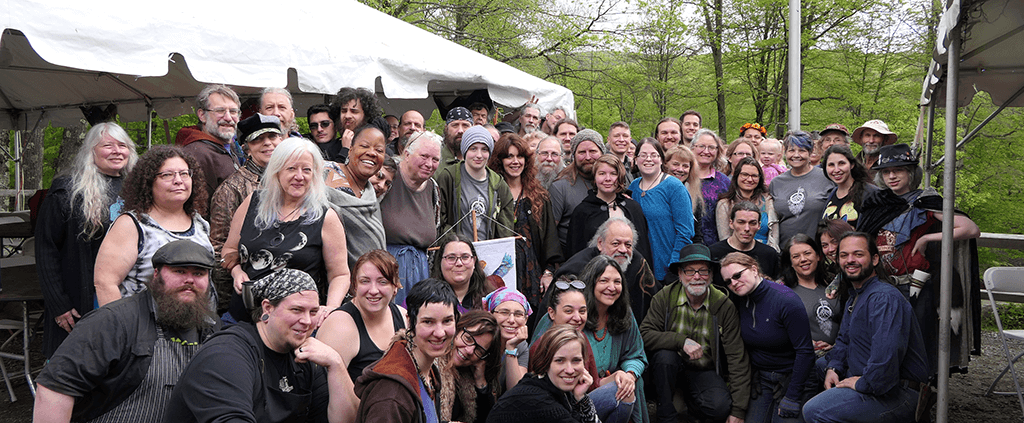
EarthSpirit has one of the longest-standing pagan events in the USA and reached a true milestone this year as we celebrated our 40th Rites of Spring and recognized and honored our first community Elders.
The other big event this year was our participation at the Parliament of the World’s Religions in Toronto. Thirty-eight members of EarthSpirit attended the Parliament. Our delegation worked as an extraordinarily strong team to staff and support an information and networking booth, and EarthSpirit members offered 16 separate and important programs. Andras Corban Arthen, EarthSpirit’s Spiritual Director, continued his very active and ongoing work on the Indigenous Task Force and on the Executive Committee of the Board, participating in planning and creating the whole of the Parliament and especially several of the plenary sessions. I was a member of the Women’s Task Force, working in advance and on site to coordinate programming involving the arts, ritual and the divine feminine, and on creating the Women’s Assembly.

There is a lot to share about that week in Toronto – what we did there and why it matters. So many EarthSpirit members did so much. Kate Greenough Richardson brought our Art Salon format into the light with the “Spirit Soaring Gallery Space and Art Salon”; Arianna Knapp designed and coordinated a very professional EarthSpirit booth, where we could share who we are with thousands of people; Donovan Arthen and Will Rowan presented a workshop called “Transforming Masculinity,” featuring the work of the Brotherhood of the Stag and Wolf; 9-year-old Vivian Seier was the overall youngest speaker on the Parliament’s Plenary Stage when she came forward to represent the dignity of women in paganism. It is too much to include everything in this letter, so a complete report of EarthSpirit’s participation at the Parliament is posted on EarthSpirit Voices and on our website. The links are below.
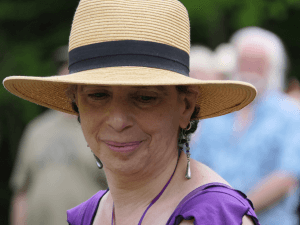
There have been some hard times this year, of course. We lost Morwen Two Feathers, an EarthSpirit Community Elder and teacher, and a great friend to many of us – and we celebrated her life together. Others in the community have also passed or suffered illness or personal losses, and we have seen the community come together to hold each other.
We are still facing major challenges in the US as well. The political climate remains tense, hate crimes are still on the upswing, and we continue to see intolerance and prejudice step boldly into the light as our government moves farther away from environmental responsibility, upholding human rights and the diversity which has so enriched this country. Many EarthSpirit members feel personally vulnerable and afraid. The need for clear information and communication, mutual support, and outreach to the diverse world around us has never been more pressing. EarthSpirit is doing what it can to provide leadership and an anchor in this time of upheaval – offering encouragement to its members and taking action when we can in places where it is needed.
The interfaith work that EarthSpirit has been committed to for so many years offers us many valuable and reassuring connections. Andras was re-elected to the role of Vice-Chair of the Board for the Parliament of the World’s Religions, an international organization that is supportive of EarthSpirit and of pagans in general. Andras also continues to serve as President of the European Congress of Ethnic Religions, and his leadership there connects us directly with people still practicing the old indigenous ways in Europe. Our Earthways Initiative reaches out specifically to Indigenous leaders in the US as well as in other parts of the world. We will continue to join forces with all of these peoples and groups, to further our work to protect the Earth and support other communities who share our values.
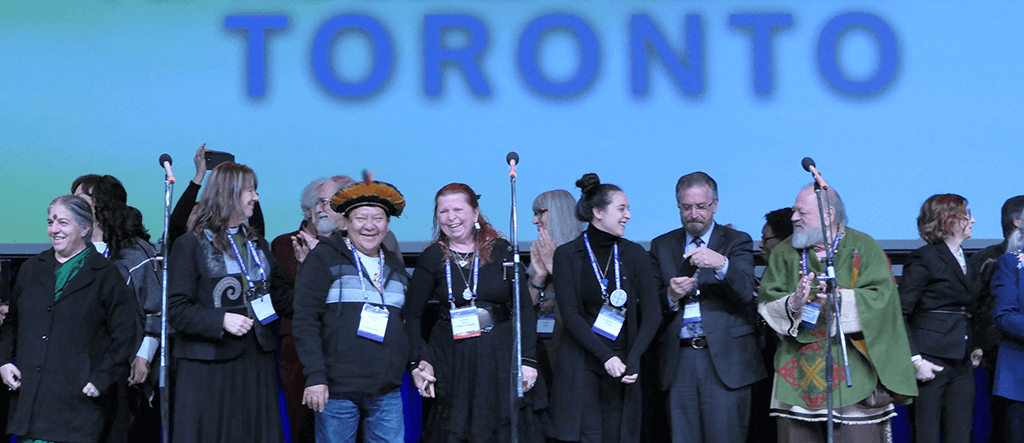
The end of the year is the time for us to wrap up our Annual Fund, so I will conclude with that. Our community has always been generous. We have consistently received contributions large and small which allow us to carry on. We appreciate every single one, as well as all of the volunteer time and expertise that our members contribute throughout the year. Members, like you, enable us to offer the rituals, classes and gatherings that create meeting places where we can build and deepen meaningful face-to-face connections. Your contributions help us maintain the sacred land of EarthSpirit’s home at Glenwood, make it possible for us to network with spiritual people around the world and also provide some financial support to community members who are ill or struggling. We are grateful.
If you have not had the opportunity to participate in this year’s fundraising yet, or you have found further inspiration in this letter to participate once again, now is a great time. We count on all of you to be a part of the web that holds us together on so many levels.
We wish you all a prosperous and healthy year ahead.
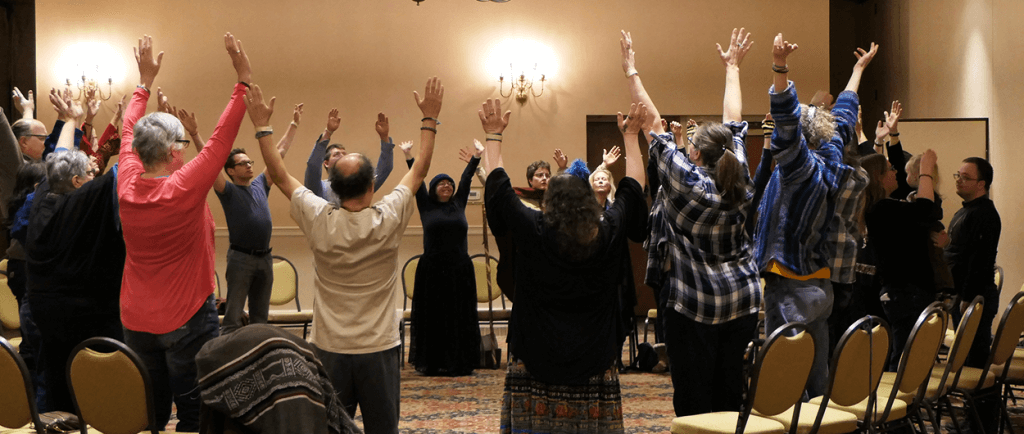
We hope to see you at A Feast of Lights this February 8-10 in Sturbridge MA!
Thank you all for being part of and supporting the EarthSpirit Community.
Deirdre Pulgram Arthen
Executive Director
You can find out more about EarthSpirit’s work through articles in “EarthSpirit Voices” , by liking “The EarthSpirit Community” on Facebook, or by visiting our website: www.earthspirit.com.
Gathering the Threads
Gathering the Threads was published May 4, 2015 by EarthSpirit Community on EarthSpirit Voices
by Sarah Lyn Eaton
Right now, the snow and ice are melting, the winds are warming, and I am dreaming of groups of people in the woods. I call them my gathering dreams. I have them twice a year. In the summer, they are in preparation of Twilight Covening. Right now I am dreaming about Rites of Spring.
At the end of May, in the beauty of the Berkshire Mountains, the EarthSpirit Community holds a gathering of earth-centered pagans from around the globe. Recovering from the darkness of winter, from our separate burrows, those of us who dream of fire and water, sunlight and starlight, start to count down the days till we can come together again. We are waiting to meet those who will step on the mountain for the first time this year. We are waiting, excitedly, because some of my closest friendships have been made at this gathering over the last decade.
The first time I attended Rites of Spring, I didn’t know the other attendees outside of the small contingent of

people from my local community. I will never forget how overwhelmed I felt to stand among so many people who believed in being open, in being kind, in being loving, and in sharing that energy with each other. Rites is my annual pilgrimage to a land that exists within our everyday world, one which we sometimes lose sight of when the hardness of the world clouds it. Over the course of my week at Rites, that spirit renews.
That spirit is contagious from day one. As everyone arrives, they are excited, joyously crossing through the Welcome Gate. Some say they are coming home when they arrive. And yes, if home if where the heart is, then we carry it with us, wherever we wander. Feet on the earth, flesh on the mountain, heart open and present.
The setting of the established mountain campground is gorgeous. The rocks, woods, and water make the immersion in nature’s wonder easy. It’s easy to be open. I walk the campground with my head up, eyes and smiles meeting both friends and strangers. You don’t have to know someone to find yourself in a deep conversation. It’s one of many gifts the gathering continues to offer.
I wasn’t new to paganism when I first arrived, but I was new to the idea of a specific path. Throughout the gathering, whether you arrive on Wednesday, or on Friday, there are workshops and rituals and concerts and drum circles and dances and so much more! Over the years I have taken classes with over a dozen different practitioners, some using the words Shaman, Druid, Buddhist, Animist, Witch, Heathen, etc. Last year, there were over seventy workshop presentations offered over the span of five days. Bring a notebook and an extra pen.
For first timers there is a newcomer breakfast, where you get to meet some of the facilitators of the event, as well as get a chance to connect with the other people new to the gathering, insuring you will see familiar faces throughout the week. You become small touchstones for each other.
During the day, if there aren’t workshops or affinity groups that tickle your fancy, check out the Art Salon or any one of the community-built shrines throughout the camp. You might walk the Merchant Circle and check out the amazing crafts and artistic wares for sale, from beautiful hand-dyed silks to stained glass, from pottery to drums, from leather masks to hand-forged blades (some created on-site!). Then in the evening there are concerts, large and small, rituals, dances of varying themes, poetry slams, sacred drum circles in the woods, and more. The week, or weekend for some, culminates in a large community-shared feast.
There are larger rituals that connect the gathering, from the Firelighting Ritual to the Maypole to the not-to-be missed Web Weaving Ritual. Hand over hand, thread over and under thread as drum and song excite the air. I want to entice you. I want you to come and add yourself to that web. I want you to come and experience the community I have become part of. Because it follows you home. And the world you see when you cross back through the gate is forever altered.
Join us this year. Be present. Throw yourself into the rituals. Smile at strangers. Take some classes. Start up random conversations in the dinner line. Weave your own web and let us be part of it.
A Year of Drops
by EarthSpirit Community on EarthSpirit Voices
Written by Katie LaFond

I celebrate the Earth as Sacred, and it started me down a path many years ago that has borne some surprising fruit. Below is a collection of simple things you can do to help live more lightly on the Earth. I consider each of these an act of prayer.
The tips are organized into 12 steps. A lot of these cross over, but this will get you started. Focus on one section at a time.
Do these at your own pace. With 12 sections, you can choose to focus on one area for the amount of time that feels right to you. If you find the pacing too fast/slow, you can always modify your habits. The point here is to see how easy it can be to weave some of these into your life. Remember that this blog post is only the beginning. This can be a lifestyle change, and will take you on interesting adventures along the way. Every drop in the bucket makes a difference.
- Get serious about Recycling
- Get serious about Reusing
- Get serious about Reducing
- Start Composting
- Use your car less
- Locate your local food options
- Where do your things come from? Try to source as many of the things you use within a 100 mile radius of your home
- Start a garden
- Look into buying “Environmentally Friendly” products.
- Energy consumption
- Get Crafty
- Educate yourself
A Year of Drops Step 1: Get Serious About Recycling
-
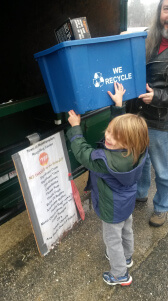
Recycling! Photo by Katie LaFond Many communities have curbside recycling or transfer stations that accept recycling. Utilize these options
- Grocery stores often have plastic shopping bag recycling stations, as well as bottle and can return facilities
- Electronics stores, like Best Buy or Staples, often accept old electronics for recycling. Go through your basement and drawers for those hidden old electronics that can get recycled which cleans out your house and frees up the resources to make new items
- Aluminum is an example of a resource that is much less costly to recycle than to produce from scratch. Recycling aluminum requires only 5% of the total amount of energy that is used for making new aluminum.
- Paper can be recycled about five to seven times before the fibers become too short to be recycled again, and saves many trees along the way (also be careful not to misprint copies, and to only make what you need… double sided, perhaps)
- No recycling available while you’re out? Put the bottle in your bag, and put it in the recycling bin at home.
- Not sure how to recycle it? Check Earth911.
A Year of Drops Step 2: Get Serious About Reusing
- Reusable shopping bags and reusable produce bags are great. Most of the reusable bags for purchase are made from polyester or plastic (which comes from fossil fuels). Purchase or make reusable bags made of natural fibers (cotton, hemp, etc) that can be composted when they are no longer usable as bags. Free patterns can be found here.
- Use reusable containers instead of plastic wrap. Bring them to restaurants for leftovers too! (I keep some in the car because I’m forgetful)
-
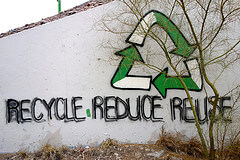
Photo by Kevin Dooley, used under a Creative Commons license Use reusable coffee mugs at the coffee shop. Keep one in your car all the time just in case you have a sudden coffee craving
- Wash your plastic freezer bags to reuse them
- Reuse containers that your food is packaged in. Spaghetti sauce jars can be useful for leftover soup, used as a water bottle, making herbal tea, as a candle holder, and to hold dried beans/nuts/etc.
- Plastic has its place. With a small child, I often use tupperware or rubbermaid containers to send his lunch to school, pyrex having the potential to smash and make an unsafe
situation for the children and teachers. Well-made plastic containers that can be used for decades and then be recycled is preferable to the disposable plastic (or styrofoam) that is often used, even if you recycle it afterward. There are also stainless steel/metal container options that you can research that can be safer for small hands. - Remember that the process of recycling often uses a lot of energy and can release chemicals that are detrimental to the health of the world and ourselves as part of it. It is often better than products ending up in landfills, but reusing is often preferable to recycling.
- Facecloth sized cotton towels/rags in the kitchen for drying hands/wiping up spills can help you avoid using paper towels. Cotton will compost when you’re done with them). Keep a basket of them handy.
- Cotton washing rags to wash your dishes can help you avoid using a petroleum based sponge. It’s also more sanitary, because you can throw the rag in the laundry at the end of the day. It can also be composted when it is no longer useful as a washing rag
- Reusable cotton napkins: keep a basket of them near the table.
- Reusable batteries. (Make sure to read the charging instructions)
- Reusable plates/silverware. My husband and I have a small tote that we use to transport 20 plates, cloth napkins, and sets of silverware with us when we attend potlucks. The used dishes go back into the tote to come home with us, and the tote then serves as a dishpan. We wash the dishes, let them dry, and then they go back into the tote to await the next potluck.
- You can also bring your own plate/napkin/silverware with you when you attend potlucks. Metal pie plates can be very useful.
- Cloth diapers. If you have a baby, cloth diapers are a great way to reduce the amount of trash you make. Bonus: it saves money! Borrow some prefolds, a variety of covers or soakers, and perhaps some “all-in-one” type diapers to determine your favorite type. See if any of your friends have some you can use, or look on Freecycle/Craigslist to buy your diapers. Washing them is not hard. Be sure not to use traditional detergent which can waterproof what we hope will be absorbent. Here is one resource.
- Reusable menstrual pads, and menstrual cups. A little pricey, but once purchased, you don’t have to buy products each month, and washing them yourself, you don’t have to worry about what chemicals are contacting your skin. Many different options are available, google “reusable menstrual pads and cups.”
A Year of Drops Step 3: Get Serious About Reducing
-

photo by Bill McChesney; used under a Creative Commons License When you throw things “away,” remember that there is no such thing as “away.” Where does it go?
- Rinse the trash you DO throw away, so that your barrel does not smell, and you can go longer between using a new (often plastic) trash bag.
- When possible, buy things in bulk to reduce the amount of packaging you’re also buying with the desired product. You can bring a cotton produce bag for bulk items.
- Make a list of everything that goes in your trash and recycling, and determine one thing each week you can stop buying that makes trash. Packaging accounted for much of my waste. Buying things in bulk and at the local farmers’ markets (I’m lucky enough to have both summer and winter farmers’ markets) cut down on much of the packaging I brought home and immediately threw away.
- It often seems cheaper and easier to just “buy a new one” for example, the drip trays underneath the burners on your stove. They can get really gross! It’s tempting to throw them away and put new ones in, but be aware of the hidden costs to yourself and the world… Soak them in baking soda and water overnight, and clean them. The more often you wash them, the less work it is.
- Water usage: turn it off! Even in water-rich areas like the Northeastern US, using water requires energy to run the pump, the water heater, etc. When you brush your teeth, don’t let the water run. I like to fill up a glass which I use to wet and rinse my toothbrush. Using a cup of water, as opposed to a gallon, makes a difference. When shaving, put a little water in the bottom of the sink instead of letting the water run.
- Consider showering by running the water just long enough to get wet. Turn it off, soap up, and then turn it back on for just long enough to rinse. If you enjoy the feeling of soaking in warm water, consider a long bath. (If you’re indulging in a bath, make it worth the water usage: relax for a half hour or more.)
- Make sure when you are doing laundry, do a full load. Doing half a load of laundry uses almost as much water and energy, but be aware; overstuffing your washer is also inefficient.
- Get into “shabby chic.” Freecycle and craigslist are a great way to make sure your unwanted items stay out of trash heaps. Acquiring the things you want and need using Freecycle or similar is also a good way to support the reusing effort. Older items can work just as well, and can add a rustic look to your house.
A Year of Drops Step 4: Start Composting
-

Photo by Joi Ito, used under a Creative Commons License Lots of resources are available if you are interested in learning how to compost. This is just one of many educational websites that are easily found.
- Compost tumblers can be an interesting option to explore, particularly in urban and suburban areas.
- Many towns also offer covered compost bins for purchase with the cost partially subsidized by the town. This can help composting happen a little faster and keep critters out of your pile. Check your town’s website to see if yours is one of them!
- If you don’t have a compost heap, bring your compost to a friend’s heap. I did this for quite a while when I lived in an apartment in the city.
- Some places will take your compost drop off. If you live in a city, check to see if there is a municipal composting program.
- If you want to compost your meat and oil, you have to get a little more advanced in your composting skills. Talk to your local expert if you’re interested in this.
- If bugs (e.g. fruit flies) are attracted to your compost, you can keep your bucket in the fridge
- Consider starting a worm bin. This can be a good option if you’re in an apartment, and can double as entertainment (worms!) if your child is like mine.
A Year of Drops Step Five: Use Your Car Less
-
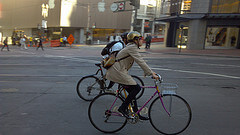
Photo by Luxomedia, used under a Creative Commons License If you’re near your workplace, ride your bike. Keep your clothes in a bag and change at work.
- If you’re near the places you do your errands, ride your bike. Child bike trailers can be handy for hauling groceries. I had a tricycle with a basket on the back which was a great grocery-getter.
- Combine trips. I do much of our household shopping on my way home from work.
- If you live in an urban area, consider public transportation or walking for short trips.
- Can you carpool? Some offices help arrange car- or vanpools too. Ask your HR department about it.
- Do you have “stuff” in your car? More weight means reduced gas efficiency. Roof racks create drag, and reduces gas efficiency. If you can remove it and only use it when you need it, consider it.
- When replacing your car, consider a more gas efficient car.
A Year of Drops Step 6: Locate Local Food Options
-

photo by Sarah Rosehill; used with permission Local farmers will often let you use your own containers, reducing the amount of plastic you take home
- Eating locally can allow you to develop a relationship with the land, animals, plants, and farmers that feed you and your family. Feeling a connection to that which nourishes us is something that my family cherishes. We take a moment to give thanks before eating, often saying our farmers’ names aloud.
- Farmers’ Markets can be found in many communities during the summer and even the
winter. I have even found Farmers’ Markets on the Mass Turnpike! - Helpful resources: CISA, Local Harvest.
- Eat food that is in season. It is often available more locally, and connect you to the cycles of the land where you live. For example, where I live, I eat asparagus and fiddleheads in the early spring, broccoli in the spring, peas in the early summer, zucchini in the summer, tomatoes in late summer, squash and apples in the fall, and root vegetables (onions, potatoes, beets, carrots) over the winter.
- Join a CSA or two. Veggies, meat, milk and cheese shares are widely available in both the city and rural areas.
- If you have the space, start a garden. Nothing is more local than your back yard! There are lots of great resources for beginning gardeners available for free online. Start by growing just one or two of your favorites.
- Be brave! Take a new food home each week and learn how to cook it. If you don’t like it at first, try one bite each day for a week. Taste can be acquired.
- It may be more expensive to eat locally, but remember that it doesn’t need to be shipped long distance and buying local food stimulates the local economy. “Cost” is so much more than a price tag.
- Cook big batches, and package meals in reusable containers (repurposed spaghetti sauce jars) to freeze for nights that you’re tempted to get take out. Remember to leave a little space at the top of glass jars before freezing!
- Processed foods come in a lot of packaging. Eating less processed food will significantly reduce your waste stream (and improve your health).
A Year of Drops Step 7: Buy Local
Where do your things come from? Try to source as many of the things you use within a 100 mile radius of your home, and choose options that are in line with your values.
-

Photo by Richard Walker, used under a Creative Commons License Candles are often made of paraffin, which comes from fossil fuels; look for beeswax instead.
- Buy what you can locally. Not only does it stimulate the local economy, it means that items aren’t being shipped cross-country to your home, which burns fossil fuels.
- Large companies have the benefit of established infrastructure to efficiently move
materials, but they are often moving them long distances, burning fossil fuels. If your item is not available at smaller, local shops, check freecycle, craigslist, and your circle of friends before buying an item that is being shipped long distances. - Support your local artisans! Many old arts (soap making, candle making, cider pressing, and more) are being reclaimed, and each time we choose to buy locally, we’re supporting the kind of communities we want to live in.
- Do you often have items shipped to your house? While it is convenient for our busy lifestyles, it means that fossil fuels are being burned to ship things to your house. Try to combine shipped purchases into larger orders to reduce the number of trips being made to your house. Currently, I’m working hard at this, as I struggle with my love of Amazon Prime and Groupon.
A Year of Drops Step 8: Start a Garden
Your own yard is the most local food possible!
-

Photo by Irene Kightley, used under a Creative Commons License Inside: put containers (pots, window boxes) in your southern facing windows. Herbs and small things like carrots and bush beans work well.
- Your local garden center can help you learn how to care for your plants. Consider your soil and make sure it has enough drainage.
- Outside you have a lot of options. You can make your garden as complicated or simple as
you’d like. Start small, add to it each year, educate yourself, read lots of books and ask for help. - You can have your soil tested for contaminants cheaply, usually through your local university extension center. In Massachusetts, UMass does this.
- Container gardens can be a great option for those in condos or apartments. These can be in or outside, and depending on the size of your container, can be as simple or complex as you’d like.
- Rooftop gardens are quickly catching on in the city. Community gardens are also popular.
- Start with easy to grow items: beans, tomatoes, carrots, garlic, and squash like zucchini and butternut.
- Plant bee- and butterfly-friendly plants like milkweed, bee balm, black-eyed susans and sunflowers to keep your local bee populations fed and healthy
- Buyer beware: pesticides are sometimes present in plants you can buy. Last year I was dismayed to learn that there were plants for purchase at a large popular store that kill bees when they visit them. Visit a local garden center where you can talk to an expert and get ideas. It might be a little more expensive in the moment, but well worth it in the long run.
A Year of Drops Step 9: Look into Environmentally Friendly Products
-
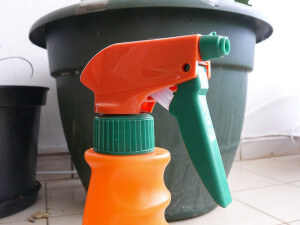
Photo by Arria Belli, used under a Creative Commons License Be aware that being “eco friendly” is now a fad, and a marketing scheme. Don’t be sucked in.
- Many times, you can make your own cleaning products. Baking soda, washing soda, borax, water, and vinegar are great natural solvents. (But be careful when mixing baking soda and vinegar, unless you’re doing a science fair project!). Here’s one resource; there are many
online. - Try castile soap in the shower, as hand soap, and as dish soap. You can even use the bars to make your own laundry detergent!
- You can make many personal care products using recipes found online. This lets you know exactly what’s in it and avoid ingredients derived from fossil fuels.
- If you have a septic tank, avoid using products that will kill the natural flora like bleach. The flora will break down your waste naturally, allowing it to cycle back into the ecosystem.
A Year of Drops Step 10: Examine Energy Consumption
-
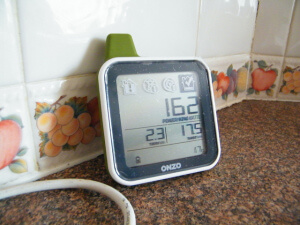
A home energy meter. Photo by Digitpedia.com; used under a Creative Commons License What sorts of energy do you use? Electricity can often be traced back to fossil fuels, but if you look into solar or wind options for your home, you can reduce some of that. You can also specify with many electric companies that your energy come from renewable sources.
- You can rent solar panels for your yard. They don’t have to be on your roof, but if you have a southern facing roof, go ahead and research options for that.
- Consider elbow grease, or being more steampunk: electricity is not the only kind of energy out there. When cleaning using natural cleaning products, you often have to use a
little more elbow grease. Consider it exercise! - If you have a woodstove, check to see how efficient it is. Sometimes, incentives are offered for upgrading to a more efficient stove. Efficient wood stoves and pellet stoves can be a great way to heat your home without using fossil fuels (remember to keep your chimney clean to avoid chimney fires). Fans are also available to circulate hot air that run on the heat power coming from your stove already.
- How much energy do you use? Consider converting to an “on demand” water heating system, so that you’re only using energy to heat water when you need it, and not to keeping a full tank of water warm when you don’t need to
- How hot/cold do you need to keep your house? Slippers, robes, and sweaters are cozy in the winter, allowing you to keep your home a little cooler, and a fan can help you stay comfortable with warmer temperatures in the summer.
- Programmable thermostats are available if you have a thermostat in your home. Bringing the temperature down 6 degrees at night can save a lot of energy. Much more than that doesn’t save as much energy as those first 6 degrees. If you’re away at school/work during the day, consider keeping the temperature low during those hours as well. Set the thermostat to warm up a half hour before you typically get home so that it is comfortable when you arrive. The best part about this option is that you can “set it and forget it.” It is a seamless drop in the bucket that takes a minimum of effort.
- Dryers are a huge energy consumer. They also slowly degrade your clothing, meaning you need to purchase new clothing sooner, which is also wasteful. Hanging your laundry inside/outside is much more efficient, and adds humidity to dry winter air inside your house. I use a retractable 5-line in the house.
- When replacing your light bulbs, consider CFL, or LED bulbs. Be aware that CFL bulbs contain mercury. Recycle them properly.
- Turn off lights when you’re not using them. Consider lower lighting in your home unless you’re reading or doing detailed projects. Consider burning a beeswax candle at night instead of using a lamp, and reconnecting to the cycles of light and dark through the year.
- Power strips will draw energy even when there is nothing plugged into them. They often come with switches; turn off your power strips when you’re not using them.
- Most chargers (phone, tablet, kindle, laptop) also draw energy even when your items are not plugged into them. Despite it being only a “trickle” of energy, it adds up, home to home. Unplug them when you’re not using them.
- Turn off the heated dry cycle on your dishwasher. Open the door at the end of the cycle and let them air dry
- Wash your laundry on a cold/cold cycle unless hot water is necessary to get them clean. Towels and diapers benefit from a hot cycle, but otherwise, laundry gets clean on a cold/cold cycle
- Many electric companies will do an energy audit for your house to help you learn where you could be more efficient.
A Year of Drops Step 11: Get Crafty
-
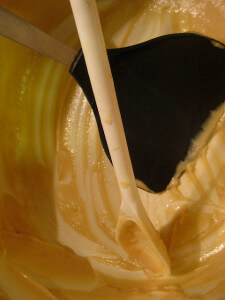
Photo by Tabatha Alcina, used under a Creative Commons license Learn to cook, sew, knit, spin, make soap, make detergent, make candles, keep bees, can food, make cheese
- Slow cookers and pressure cookers simplify a lot of home cooking and
allow you to make your own “convenience food.” - Keep your meat bones and use them to make broth. You can keep them in the freezer until you’re ready to make broth. Also consider keeping onion skins, carrot tops, and other food waste that can add complexity and nutrition to your broth
- Keep in mind that in any area where you know how to make your own, you’re a more informed consumer
- Split the work up and share your responsibility with your housemates or family
- Create reminders for yourself so you can keep up on periodic tasks: google calendar alerts, sticky notes…
- Organize your house to make it easy to do all these things: keep baskets of rags in your kitchen and a couple of recycling buckets handy so you can sort as you go. Hanging them vertically on the wall with hooks can be super handy.
A Year of Drops Step 12: Educate Yourself
-

Photo by Randy Adams, used under a Creative Commons license Read books like Garbology, Cradle to Cradle, The Backyard Homestead and Rubbish!
- Go to lectures and workshops
- Places like The Haberdashery, and even the mass.gov website have many great classes you can take to learn new skills
- Join movements! If you want to be included in emails about upcoming events, please email us at earthspirit@earthspirit.com
- Lead by example. Not all activism is marching. If your friends and family ask about your new habits, you have some experience now. Tell them about your experiences, reference the materials you’ve used, or you can direct them to this blog post to get started themselves.
End of Year Letter 2017
Dear friends,
As we move into the winter and toward the end of the tax year, we again invite all of our members to contribute to EarthSpirit’s annual fund to support the work it does all year round.
This year EarthSpirit turned 40 years old! For four decades, EarthSpirit has sustained and nourished a community that supports families and individuals in truly living their spirituality, maintaining and passing along pagan cultures and traditions in a world that does not always share our values. Generous donors, like you, enable us to offer the rituals, classes and gatherings that create meeting places where we can build and deepen meaningful face-to-face connections, network with spiritual people around the world and also provide some financial support to community members who are ill or struggling.
This year has seen some exciting developments. We have a beautiful new website, our first full reconstruction in 20 years! If you have not visited it yet, please travel over to www.earthspirit.com and see what our excellent designer, Moira Ashleigh, of SolsticeSun Design, has created. At Glenwood, we have also just activated our big new solar panel array which will power our offices and Community Center as well as some of the residences there. We are thrilled to be moving toward a lower impact energy footprint.
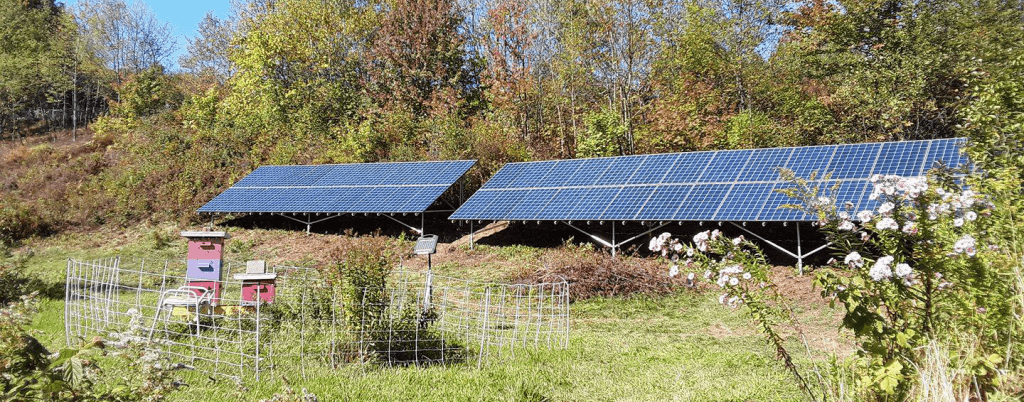
EarthSpirit’s Board of Directors expanded this year with the addition of three new members and the retirement of one. Board members now include: Andras Corban Arthen, Deirdre Pulgram Arthen, Kaye Hughes Kittredge, Moira Ashleigh, Susan Curewitz Arthen, Sarah Rosehill, Eric Leventhal Arthen, Kate Greenough Richardson and Donovan Arthen. Leona Stonebridge Arthen retired with our thanks for her many years of dedication.
The year has also brought challenges, of course. The political climate remains tense, hate crimes are on the upswing, and we continue to see intolerance and prejudice step boldly into the light as the US moves away from environmental responsibility and closer to war. The most vulnerable among us, those in poverty or in minority groups, are endangered and many EarthSpirit members feel personally afraid. The need for clear information and communication, mutual support, and outreach to the diverse world around us has never been more pressing. EarthSpirit is doing what it can to provide leadership and an anchor in this time of upheaval – offering encouragement to its members and taking action when we can in places where it is needed.
This year we organized delegations to participate in the Washington DC Climate March and the Boston protest against the white-supremacist “free-speech” demonstration. Many of us have represented EarthSpirit at community meetings and spoken or sung at other public events resisting the current wave of climate change denial and neo-fascist aggression.
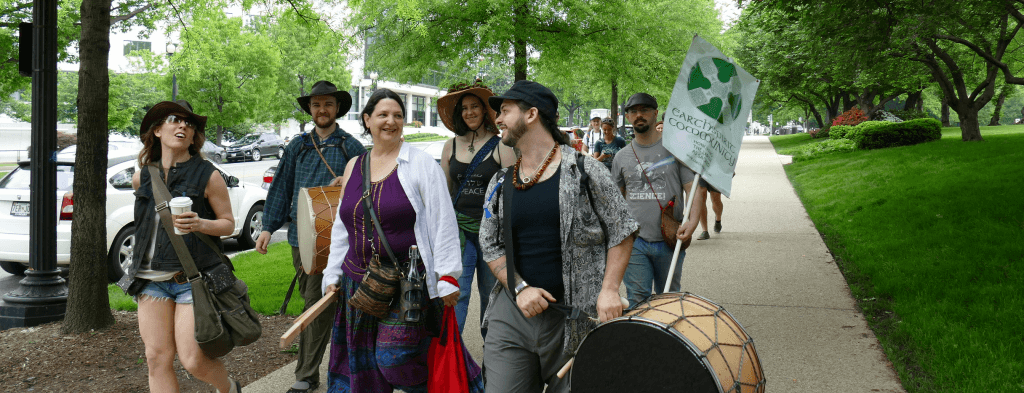
The interfaith work that EarthSpirit has been committed to for so many years offers us many valuable connections. Our spiritual director, Andras Corban Arthen, continues to serve as Vice-chair of the Board for the Parliament of the World’s Religions. EarthSpirit and its members are well-known to many in that organization and they are supportive of us. In this capacity Andras will be an invited speaker at the UN this January, at a symposium on the Role of Religion and Faith-based Organizations in International Affairs.
Andras was again elected President of the European Congress of Ethnic Religions and his leadership there connects us directly with people still practicing the old indigenous ways in Europe. Our Earthways Initiative reaches out specifically to Indigenous people in the US as well as in other parts of the world. We will continue to join forces with all of these peoples and groups to further our work to protect the Earth and support spiritual communities devoted to it.
Looking to the year ahead, we have already registered a 30-person delegation to attend the 2018 Parliament of the World’s Religions in Toronto to represent EarthSpirit and its members, staff an informational and networking booth, and offer a range of programs. Deirdre Pulgram Arthen, EarthSpirit’s Executive Director, is serving on the Women’s Task Force this year, working specifically on coordinating programming involving the arts, ritual and the divine feminine. Andras continues his active work on the Indigenous Task Force and on the Executive Committee of the Board. In order to support those who will travel to Toronto with at least partial subsidies, to fund the booth and to cover costs of printing and product production, we need to raise $25,000 or more – in addition to our usual operating expenses. It is a tall order in one year, but we are optimistic.
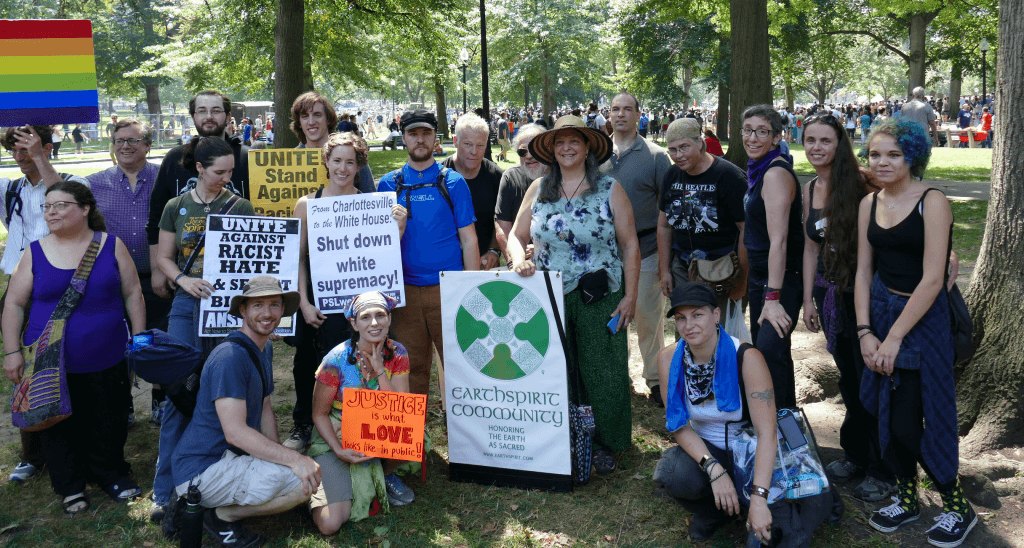
As these things move forward, EarthSpirit continues its day-to-day services. In the US this year, we again hosted more than a dozen seasonal rituals in both eastern and western Massachusetts. We reached out to the public at Boston Pride, at academic institutes, Pagan Pride events, environmental actions and at other festivals and interfaith services. We performed handfastings, baby blessings and funerals, counseled members in need, and supported those facing medical and emotional crises. We made improvements to the ritual spaces at Glenwood, our center and sanctuary in western Massachusetts, which we open to the community as part of the Sacred Land program on a monthly basis. We continued working to develop a long-range strategic plan for the organization, and made strides toward improving our infrastructure.
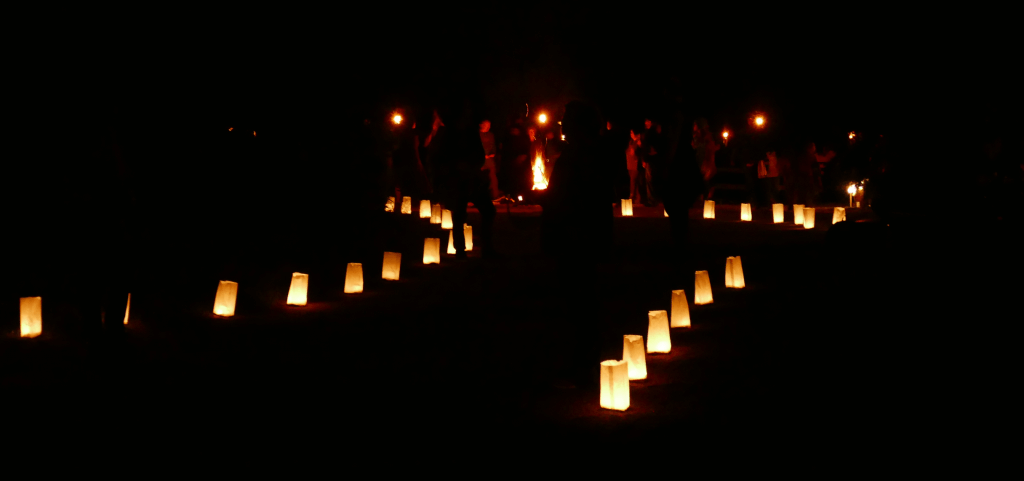
All of this work in so many areas requires a significant amount of funding to sustain it. Outreach and activist efforts which include travel, like participation at recent climate, women’s and anti-racist demonstrations, can add expense. Right now you may be overwhelmed with the many choices of worthy causes to which you can donate money. We hope that you will recognize EarthSpirit as an organization that serves you and those you care about – whether you know them personally or not – as well as one that steps up and acts when that is needed.
Our community has always been generous. We have consistently received contributions large and small which allow us to carry on. We appreciate every single one, as well as all of the volunteer time and expertise that our members contribute throughout the year. We are asking you to please consider increasing your financial donation to EarthSpirit this year to support our work to address the current challenges, attend the Parliament of the World’s Religions in 2018, and to continue to move forward with our ongoing projects. We count on all of you to be a part of the web that holds us together on so many levels.
We wish you all a prosperous and healthy year ahead.
Thank you all for being part of and supporting the EarthSpirit Community!
Deirdre Pulgram Arthen
Executive Director
You can find out more about EarthSpirit’s work by liking “The EarthSpirit Community” on Facebook
or by visiting our website: www.earthspirit.com .
Confronting Racism, Yankee Pagan Style
by EarthSpirit Community on EarthSpirit Voices
Written by Cat Chapin-Bishop
I am a Yankee. Right down to my Pagan soul.
My understanding of what it means to be a Pagan is to try to live in right relationship with the gods, the land, and the people, including the ancestors. My gods are those that are comfortable in New England’s woods and hills. My land is this rocky landscape of New England. And my people and my ancestors–on Mom’s side, at least–are New Englanders: sea captains and dairy farmers, teachers and laborers. Whatever granite is in this place or in my ancestors lives on in me and in my Pagan practice.

And that granite is why I am so driven to speak out against racism.
To help me explain what I mean, I’m going to go ahead and borrow an ancestor: my friend Kirk White‘s father.
A Yankee like a Rock
Kirk’s ancestors, like mine, were among the first Englishmen to arrive in North America. Like mine, this landscape was where they found their home. And like me, my friend Kirk and his family before him has loved New England–Vermont in his case, Maine and Massachusetts in mine.
Now, Kirk grew up on the farm his family had owned for over a hundred years. Farming in New England, though, has never been an easy way to earn a living, and, like other families before and since, Kirk’s family found other ways to pay their bills. So when Kirk was growing up, his dad Ron was a contractor.
During the real estate boom of the 1970s, Ron got hired by a big developer to build houses for vacationers in Vermont. There was a lot of money changing hands.
Now, standard practice in construction, then and probably now, says that the people under you get paid when you get paid. So the construction workers get paid when the contractor gets paid, and the contractor gets paid when the developer gets paid. But sometimes, there are delays. And on this job, there were lots of delays.
People have to eat. Ron had a crew under him, filled with workers who needed to eat, and who couldn’t wait until next month or next year to do that. So Ron took out loans, and did what he had to do so that all the people working under him got paid. Because he knew what it was like, to need to feed your kids today on money you won’t have until tomorrow, and he wasn’t going to make people deal with that.
Then it turned out that that particular developer wasn’t going to pay anybody; his deals had gone sour. He declared bankruptcy, and Ron and his crew were way too far down on the food chain to ever get a share.
Ron had paid his workers. They were fine. But Ron’s debts were all in his own name, and he had no way to pay them. Worse: that was the year his house burned down. One of Ron’s sons died. His wife had a heart attack. It was just that kind of year.
The sensible thing to do would have been to follow the developer into bankruptcy, but Ron couldn’t make himself do that. He felt himself honor-bound to repay all those loans, all that money. No court would have held him to it–but his own integrity did. So he busted a gut doing every kind of work he could lay hands on. His wife went back to work, despite her heart. They couldn’t rebuild the house, so they moved into a trailer… and Kirk grew up in something very near poverty.
Ron scrimped and saved and drove himself for years and years… and in the end, he paid it all back. Every last dime.
Well, almost.
In the end, it was Kirk himself who paid that last $40,000, when he took possession of the farm–and the integrity–that came down in the family to him.
When I began working on this essay, I called him on the phone. I’d only heard the story once, though obviously it had left me with a strong impression. Then, after some basic fact-checking, I asked Kirk the question that had been on my mind. I asked if, growing up, he’d ever resented it–making do with so little when, if his Dad had been a little less unyielding, he might have had so much more.
“To be honest,” he said, “I never thought of it until just now, when you asked.”
He paused, thinking. “It always just seemed to me that it was the right thing to do–the honorable thing. I guess I just… admired him for it.”
And that, to me, is integrity. Integrity like bedrock, like the land itself.
When I say that “I’m a Yankee,” what I mean is, I consider myself to be walking in the footsteps of men and women like Ron White. Granite integrity may be hard to live up to, but like Kirk, that’s the kind of person I aspire to be.
That is what I’m proud of. But–and if you are a black or brown reader of this blog, you’re probably here way ahead of me–I don’t get to hold onto the pride of my heritage unless I’m willing to own the shame.
Receiving Stolen Goods
Our Yankee forebears were not innocent of the stain of racism. Neither, for that matter, am I.
I’m not just talking about slavery–though all the New England states had slavery; they just ended it a little sooner than other parts of the country. (Should we make a virtue out of having ended the theft of lives sooner–through a gradual emancipation–than other parts of the country? “We Stole a Little Less Than Some White People!” what a ringing endorsement of our integrity!)
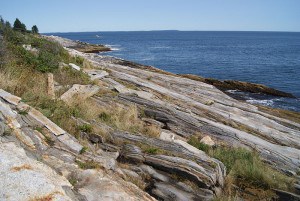
I do not stand apart from these injustices. My ancestors profited from a system that marginalized and robbed people of color. Those sea captains I’m so proud to claim in my family tree? The New England shipping industry was built on the Triangular Slave Trade. Whether my direct ancestors ever participated is almost beside the point: the industry was created by it. Likewise Maine farmers owed their prosperity, in part, to supplying that same industry, before as well as after the abolition of the slave trade.
It would be one thing if the injustice had stopped when the Age of Sail had ended. Then I could at least hold my father’s side of the family innocent bystanders to the crimes of racism! But it’s not so.
Did you know, for instance, that Maine wouldn’t allow Native Americans to vote until 1953? And not only was the land I love so much stolen from its original owners, but Indian children, growing up in Maine, were stolen from their families in order to “kill the Indian” in them right up through the 1990s.
Then there are the ways that, during my lifetime and my parents’ lifetimes, my prosperity, as a white woman, was assured in part by denying people of color equal access to government help. From the benefits of the GI Bill to FHA loans, my government colluded with banks, realtors, and colleges to be sure that my (white) ancestors would prosper through programs deliberately designed to discourage access by people of color.
I never asked for this. My parents never asked for this. Nevertheless, the fact remains: my family’s prosperity was paid for in part by the marginalization of people of color, in New England and elsewhere.
Honoring my Ancestors; Honoring my Debts
Here’s what I conclude from all this: I owe a debt. If you are a white American, until and unless we stop getting preferential treatment in hiring, education, housing, and law enforcement, you owe a debt. Whether our specific ancestors ever intended to cheat anyone really is not the question–at least, not to me.
Ron didn’t set out to steal from anyone, after all. He didn’t sit back and say, “That was so long ago,” or “It wasn’t my fault,” or “It’s not my problem.” Knowing he had a debt, he worked until he managed to pay it back.
If I am to claim that bedrock as my own, can I do less? As Ta-Nehisi Coates has observed,
One cannot escape the question by hand-waving at the past, disavowing the acts of one’s ancestors, nor by citing a recent date of ancestral immigration. The last slaveholder has been dead for a very long time. The last soldier to endure Valley Forge has been dead much longer. To proudly claim the veteran and disown the slaveholder is patriotism à la carte.
What will honoring this debt entail? Will it involve reparations, a financial recognition of hardships imposed? Perhaps. At the very least, it will involve breaking the silence, listening to an honoring the experiences of people of color, and confronting the complicity of white Americans.
Racism exists. It hasn’t gone away, and in fact, it’s still killing people, still destroying lives.
I am a white American. I didn’t ask to have anyone cheated out of anything. I never signed up for it; I never wanted it. But I am also a Pagan and I honor my ancestors. Here is the lesson I choose to take from them: It doesn’t matter if it’s “not our fault.” Before there can be Reconciliation, there must be Truth.
We need to be like Ron. Pay our debts.
Speak the truth, work like hell, and pay that goddamn debt.
Cat Chapin-Bishop is a longtime member of the EarthSpirit Community and a regular presenter a A Feast of Lights. To hear more from her, check out her blog, Quaker Pagan Reflections, on the Patheos Pagan Channel, where this post was originally published in March of 2015. Special thanks to Cat and to Pagan Channel editor Jason Mankey for their assistance in allowing us to repost this.


